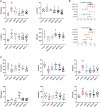Systematic Survey of the Alteration of the Faecal Microbiota in Rats With Gastrointestinal Disorder and Modulation by Multicomponent Drugs
- PMID: 34803663
- PMCID: PMC8596021
- DOI: 10.3389/fphar.2021.670335
Systematic Survey of the Alteration of the Faecal Microbiota in Rats With Gastrointestinal Disorder and Modulation by Multicomponent Drugs
Abstract
Gastrointestinal disorder (GID) is a global health disease which leads to heavy public medical burden. Disorders in the intestinal flora have been found in gastrointestinal disorder patients. However, the interaction between GID and the intestinal flora in faecal has not been studied comprehensively. In addition, multicomponent drugs represented by traditional Chinese medicine (TCM) are widely used for treating GID, but their modulation of the intestinal flora has not been investigated. Therefore, in this study, a high-throughput sequencing strategy was used to investigate alterations in the intestinal flora in a rat GID model, followed by an investigation of the modulation by a representative TCM, Xiaoerfupi (XEFP) granule. The results showed that in rats with GID, the relative abundances of Erysipelotrichaceae, Lachnospiraceae, Streptococcaceae increased and that of Ruminococcaceae decreased. At the macro level, the levels of LysoPC(16:0), LysoPC(20:2), LysoPC(15:0), LysoPC(20:2 (11Z, 14Z)), LysoPC(20:1), LysoPC(15:0), LysoPC(20:0) and LysoPE (0:0/20:0) in serum increased and levels of PC(36:4), PC(38:4), PC(o-36;4), PE (MonoMe(13,5)/MonoMe(11,5)) decreased. The imbalance of metabolites was restored by XEFP through ether lipid metabolism pathway. Increase in the phyla Firmicutes/Bacteroidetes (F/B) ratio of the GID rats was restored by XEFP as well. Moreover, XEFP can relief the symptoms of GID rats by increasing bacteria Ruminococcaceae and decreasing Streptococcaceae, Erysipelotrichaceae and Lachnospiraceae in faecal microbiota level. This study represents a comprehensive survey of the interaction between GID and the intestinal flora and a systematic evaluation of modulation by a multicomponent drug.
Keywords: XEFP; functional dyspepsia; intestinal flora; metabonomics; network pharmacology.
Copyright © 2021 Wu, Wu, Wu, Wu, Ji, Xu, Zhang, Wei, Zhao and Yang.
Conflict of interest statement
The authors declare that the research was conducted in the absence of any commercial or financial relationships that could be construed as a potential conflict of interest.
Figures







Similar articles
-
Determining the protective effects of Yin-Chen-Hao Tang against acute liver injury induced by carbon tetrachloride using 16S rRNA gene sequencing and LC/MS-based metabolomics.J Pharm Biomed Anal. 2019 Sep 10;174:567-577. doi: 10.1016/j.jpba.2019.06.028. Epub 2019 Jun 21. J Pharm Biomed Anal. 2019. PMID: 31261038
-
Xiaoerfupi alleviates the symptoms of functional dyspepsia by regulating the HTR3A and c-FOS.Biomed Pharmacother. 2019 Dec;120:109442. doi: 10.1016/j.biopha.2019.109442. Epub 2019 Sep 20. Biomed Pharmacother. 2019. PMID: 31546083
-
Precise and systematic survey of the efficacy of multicomponent drugs against functional dyspepsia.Sci Rep. 2019 Jul 24;9(1):10713. doi: 10.1038/s41598-019-47300-7. Sci Rep. 2019. PMID: 31341240 Free PMC article.
-
Research progress in the treatment of an immune system disease-type 1 diabetes-by regulating the intestinal flora with Chinese medicine and food homologous drugs.Biosci Microbiota Food Health. 2024;43(3):150-161. doi: 10.12938/bmfh.2023-068. Epub 2024 Feb 21. Biosci Microbiota Food Health. 2024. PMID: 38966054 Free PMC article. Review.
-
Intestinal Flora: A Pivotal Role in Investigation of Traditional Chinese Medicine.Am J Chin Med. 2021;49(2):237-268. doi: 10.1142/S0192415X21500130. Epub 2021 Feb 20. Am J Chin Med. 2021. PMID: 33622213 Review.
Cited by
-
Carbon dots induce pathological damage to the intestine via causing intestinal flora dysbiosis and intestinal inflammation.J Nanobiotechnology. 2023 May 25;21(1):167. doi: 10.1186/s12951-023-01931-1. J Nanobiotechnology. 2023. PMID: 37231475 Free PMC article.
-
Biomarkers for isolated congenital heart disease based on maternal amniotic fluid metabolomics analysis.BMC Cardiovasc Disord. 2022 Nov 20;22(1):495. doi: 10.1186/s12872-022-02912-2. BMC Cardiovasc Disord. 2022. PMID: 36404327 Free PMC article.
-
Aqueous extracts of Elsholtzia ciliata and Hovenia dulcis ameliorate loperamide-induced constipation in mice by promoting intestinal peristalsis and barrier function and the abundance of intestinal beneficial bacteria.Front Microbiol. 2025 May 13;16:1531232. doi: 10.3389/fmicb.2025.1531232. eCollection 2025. Front Microbiol. 2025. PMID: 40432966 Free PMC article.
-
Improvement of functional dyspepsia with Suaeda salsa (L.) Pall via regulating brain-gut peptide and gut microbiota structure.Eur J Nutr. 2024 Aug;63(5):1929-1944. doi: 10.1007/s00394-024-03401-2. Epub 2024 May 4. Eur J Nutr. 2024. PMID: 38703229
-
Metabolomics Combined with Transcriptomics Analysis Revealed the Amino Acids, Phenolic Acids, and Flavonol Derivatives Biosynthesis Network in Developing Rosa roxburghii Fruit.Foods. 2022 Jun 1;11(11):1639. doi: 10.3390/foods11111639. Foods. 2022. PMID: 35681389 Free PMC article.
References
-
- Chen G., Feng P., Wang S., Ding X., Xiong J., Wu J., et al. (2020). An Herbal Formulation of Jiawei Xiaoyao for the Treatment of Functional Dyspepsia: A Multicenter, Randomized, Placebo-Controlled, Clinical Trial. Clin. Transl. Gastroenterol. 11, e00241. 10.14309/ctg.0000000000000241 - DOI - PMC - PubMed
Publication types
LinkOut - more resources
Full Text Sources

